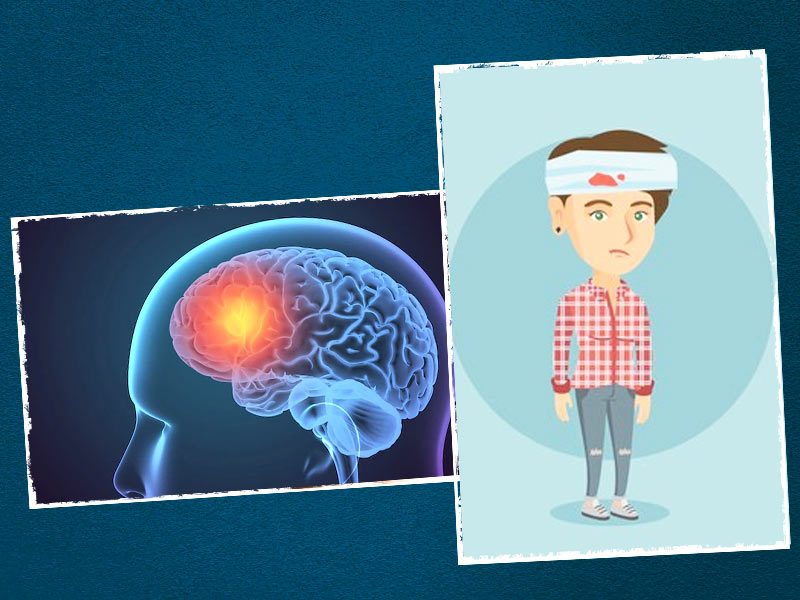
Head injury defines a vast array of injuries that can occur on the scalp, skull, brain and/or underlying tissue and blood vessels of the brain, the damage ranges from mild to severe even leading to death. Head injuries commonly are known as TBI (Traumatic Brain Injury) or Brain Injury in the medical world. The injury can be as mild as bump, bruise (contusion), or cut on the head. Head injury can be either closed or open. In this article Dr. Bhupesh Kumar, Neurologist at Neuro & Pain Care Clinic explains how to handle a head injury to prevent complications.
Table of Content:-
Types of head injuries
Before heading to remedies, let us first explains to you the types of head injuries to give an idea of what is treatable through initial aid. Head injuries can be classified into the following:
Concussion - Concussions means instant loss of awareness, consciousness or alertness for a few minutes up to a few hours following a traumatic event such as a soccer ball hitting on your head hard, or a cricket ball or sudden fall on the ground.
Skull fracture - as the name suggests, the skull is broken by an external object may be a rod hitting on the head and breaking the skull or a object hitting on the head and braking the skull and entering or not entering the brain.
Intracranial Hematoma/haemorrhage- Intra cranial hematoma means that there is blood in or around the brain causing it to swell and increasing the pressure on the brain, this type of head injury can range from mild to life threatening, as our brain is sitting around in a tight environment (the skull) so any sudden ICH can increase the pressure in the brain (Intra cranial pressure) and can force the brain to have midline shift inducing serious complications even involving surgeries.

Also Read: Expert Tells 7 Ways To Prevent Sports And Exercise Injury
What head injuries can be given first aid?
Depending on the type of injury, treatment may include:
- Putting an ice pack on the head (in a case of very mild head injury followed by a consultation with a neurologist)
- Rest
- Bandage on the area of wound
- Observing the patient for any signs of convulsions(seizures), vomiting or nausea
- If the head injury is moderate or severe then immediate medical attention to the patient should be given by calling an ambulance or taking the patient to the nearest hospital.
Treatment or first aid can be decided on the bases of the extent of injury, if the patient has a severe head injury, they will require monitoring and observation in the hospital for increased intracranial pressure followed by a Head CT (NCCT) to check for any signs of ICH. Since the brain is covered by the skull, there is only a small amount of room for it to swell, this causes pressure inside the skull to increase that can eventually lead to brain damage.

Also Read: Here Are The Types, Symptoms, Causes And Treatment Of Brain Injuries
First Aid Remedies in case of a head injury
As explained earlier head injury can range from mild to life threatening, the best you can do is to check for the following signs when a person has received a head injury:
- Stop any bleeding by firmly pressing a clean cloth around the wound, ensure that your hands are sanitised before touching the wound else that would risk an infection.
- If you see a serious head injury, ensure that the head of the person is stable and not moved. Besides, if there is persistent bleeding, put layers of cloth on the injured part to soak the blood.
- Ensure enough airway is given to the patient do not crowd the patient.
- If the injured person is vomiting, carefully move the body to one side. This process keeps the spine protected. Generally, children vomit after suffering from a head injury. Don’t panic, consult a doctor.
- Apply ice packs to swollen areas (cover ice in a towel so it does not directly touch the skin).
When to seek immediate immediate medical help for head injury?
Depending on the extent of the injury medical attention is decided for head injuries for instance, if the patient has met with an accident and has severe head injury immediate medical attention is required, but if a sports player had a sports injury where in an object touched their head then they should be observed first with a help of a neurologist who can guide them to necessary medical attention.
Image credits- freepik
Also watch this video
How we keep this article up to date:
We work with experts and keep a close eye on the latest in health and wellness. Whenever there is a new research or helpful information, we update our articles with accurate and useful advice.
Current Version